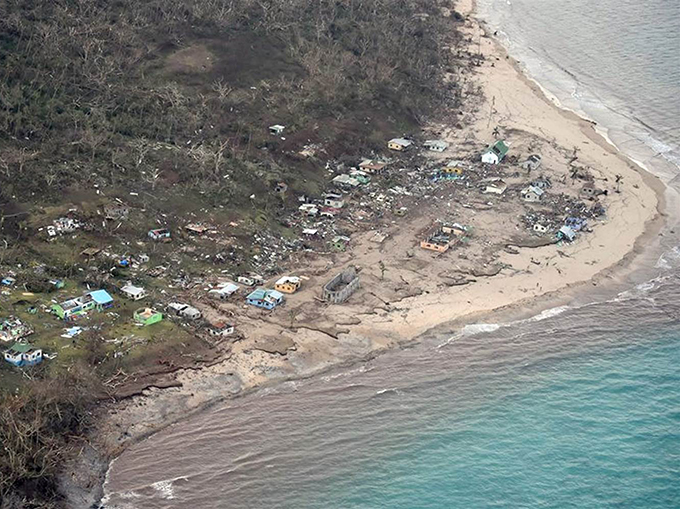
By Dr Sushil K Sharma in Suva
The term “Hurricane Winston” can be used instead of Severe Tropical Cyclone Winston for brevity similar to the common references in the past, for example, Hurricane Bebe in 1972. For one thing the term “Severe Tropical Cyclone Winston” is a mouthful and too long for people in the media and the general public to use on a day-to-day basis.
Hurricane Winston is more apt despite being short. The term clearly suggests that Winston attained hurricane force winds.
All systems in our region are not only tropical origin but also cyclonic in nature, meaning winds rotate in a clockwise manner around the centre of the system.
Severe does not necessarily give the general public any understanding of its true strength but once the term “hurricane” is used, it is understood clearly that the system is of the top-notch category with sustained winds of 10-minute average of 64 knots or over.
The momentary gusts – wind gusts lasting for a few seconds or minutes — can be estimated by adding 50 per cent of the 10-minute average sustained winds to arrive at the damaging gust value. Thus if the forecast was for 220 knots for Hurricane Winston, the damaging momentary gusts would be 220 knots plus 110 knots (50 percent of 220 knots) to arrive at the estimated top strength of the gusts, which in this case would be 330 knots.
It should be noted that wind speeds fluctuate like a sine-wave with differing amplitude and frequency in very short 10-minute periods, as you may have noted during Hurricane Winston. Thus in an average 220 knots speed hurricane, you would expect winds to fluctuate between 110 knots and 330 knots.
Many people may question building standards by just looking at the extent and arial variation of damage in a region. This is an unfair comparison as the winds are very different from one house to the other in a region depending on the exposure and wind channelling between hills, mountains, trees, small breakers like trees and buildings.
Media talk of building standards
Further, we note that people in the media always talk about building standards during these events, as if by looking at the destruction to buildings they can correctly assess the situation. They always wrongly assume that each house was faced with the same velocity (wind speed and direction) force.
They hardly ever comprehend that winds change direction and hit localities from more than one direction, as Hurricane Winston showed, hitting some homes from the southerly direction first and then turning westerly after an hour and finally becoming easterly at full hurricane speed.
The airflow during a cyclone is very turbulent and dynamic in nature. Apart from plane horizontal winds that the general public think of, during Hurricane Winston or any other similar systems, there would be very strong downdrafts — that is vertically downward flow hitting the earth from the upper atmosphere around the central regions of the hurricane. There would also be severe vertically upward wind flow out and away from the central regions of the system.
It should also be noted that at the same time the cyclone is moving away horizontally on the surface of the earth. Thus apart from the revolving horizontal cyclonic winds, we also have upward and downward — that is both vertical and horizontal wind motions simultaneously in the atmosphere in a three dimensional manner.
Talk of building standards for a system such as Hurricane Winston is sheer nonsense. No developing nation in the Pacific can adequately cover for and take precautions in their buildings for 330 knots winds.
Winds of this type have enough momentum to uproot entire buildings structures and flatten concrete walls of any type. The three dimensional nature of the varying forces applied to structures both inside and outside the walls of buildings, with winds changing directions to loosen them from all sides during the passage of these systems, should also be considered.
The speed of passage of a tropical cyclone across a nation, region or small geographical area is also responsible for the extent of damage. Hurricane Winston was a very fast moving system, which meant that the extent of damage was very limited.
Slower systems
Often systems take two to three times more time moving only at 3-8 knots speed compounding geometrically the damage as structures weaken in real time. Weaker winds are able to do more damage as the system lingers in an area.
Hurricane Winston was also a very small diameter-system which meant that the area of damage was very limited.
Of note, and one thing that people almost always forget is that the air pressure is very low indeed in the central regions of the cyclones. Unlike what people believe, the system as it was moving over the sea, would have uneven sea levels — with the sea elevated 20-30 metres in the central regions of the system.
As Hurricane Winston was moving, making landfall, the water levels would suddenly rise over the island in the ocean or coastal region 20-30 metres suddenly. Storm surge damage is a major issue in systems such Hurricane Winston where cyclones often wipe out entire coastal regions.
Fiji should thank God, as from my own analysis, the nation was spared from a major catastrophe. The system was headed right for the Capital City, where it would have wreaked havoc, with deaths in many thousands with the city almost wiped out from the map of the nation with its 330 knots gusting winds. We were spared as the system passed over less populated regions and the fact that the eye of the centre appears to have been away at sea, with minimal or no storm surge damage.
God definitely was on Fiji’s side. For a scientist like me who has spent his entire life in this field, I can categorically say that people need to be more positive as we were saved from a major carnage and destruction. The tragic scenario envisaged did not eventuate, though every single death or damage is not small.
We have just seen nature at full play with Hurricane Winston. As a community we have to learn to respect nature and adapt to live with it.
We cannot fight nature or any act of God.
Dr Sushil K Sharma is an associate professor of meteorology in Fiji.This article was first published in The Fiji Times










































[…] Dr Sushil K Sharma argued last week, a major category five cyclone like Winston was far too strong for even well-built […]
Comments are closed.